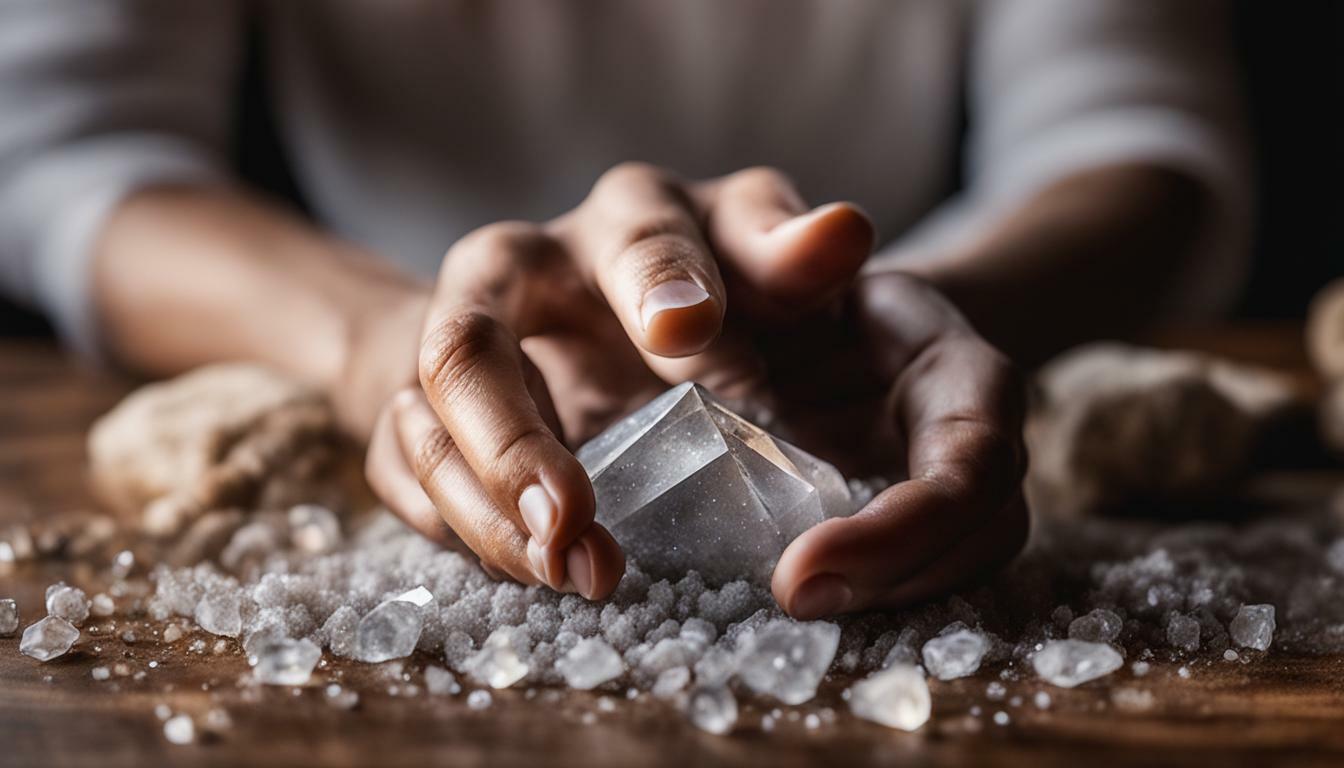Key Takeaways:
- Polishing crystals by hand can be done using various methods, including sandpaper, a Dremel hand tool, a rock tumbler, or powdered polish.
- The wet and dry method with sandpaper involves starting with a low grit (180) and gradually progressing to higher grits (400, 600, and 1200) for a polished finish.
- The Dremel hand tool offers versatility for cutting, sanding, buffing, and polishing gemstones with the right attachments.
- A rock tumbler can be used to wash, smooth, and polish crystals in multiple stages with water and special sand.
- Polishing with powdered polish and a clean cloth or leather strip is another option, requiring careful handling and consideration of stone type and jewelry condition.
Manual Crystal Polishing Methods
Discover simple and effective methods for polishing your crystals by hand, using everyday tools and materials.
To begin, one popular method is using sandpaper. This technique involves the use of different grits of sandpaper to gradually smooth and polish the surface of your crystals. Start with a lower grit sandpaper, such as 180, and rub the crystal against the rough side of the sandpaper while applying water. This wet and dry method helps to create a smooth facet on the crystal. Continue the process with progressively higher grits, such as 400, 600, and 1200, until you achieve the desired polished finish.
Another option is to use a Dremel hand tool, which offers a variety of attachments for cutting, sanding, buffing, and polishing gemstones. This versatile tool allows for more precise control and can be especially useful when working on smaller or intricate crystals. Be sure to select the appropriate attachments and follow best practices to achieve a professional-looking finish.
| Sandpaper Method | Dremel Hand Tool Method |
|---|---|
| ✓ Can be done at home | ✓ Offers precision |
| ✓ Requires different grits of sandpaper | ✓ Various attachments available |
| ✓ Involves wet and dry method | ✓ Best for smaller or intricate crystals |
If you prefer a hands-off approach, using a rock tumbler can yield great results. This method involves placing your crystals into the tumbler with water and special sand. The tumbler will tumble the stones for a specified period, which will wash, smooth, and eventually polish the crystals. The process may take several weeks, but it can produce beautifully polished gemstones with minimal effort on your part.
Remember to always handle your crystals with care and consideration. Certain stones, like opals or pearls, may require specific polishing methods or avoid polishing altogether to preserve their delicate nature. Additionally, assess the condition of your jewelry before polishing to avoid any potential damage. With proper techniques and the right tools, you can achieve stunning polished crystals that will shine and sparkle.
Using Sandpaper for Polishing Crystals
Learn how to effectively use sandpaper to manually polish your crystals, step by step. Sandpaper is a versatile tool that can help you achieve a smooth and polished finish on your gemstones. Here is a simple guide to get you started:
- Start by laying the lowest grade sandpaper, such as 180 grit, rough side up on a stable surface.
- Pour water onto the sandpaper to create a wet surface. This helps to prevent scratches and allows for better polishing.
- Gently rub the crystal over the wet sandpaper, using circular or back-and-forth motions. This will create a smooth facet on the stone.
- Continue polishing the crystal, gradually progressing to higher grit sandpaper, such as 400, 600, and 1200. Each time, make sure to wet the sandpaper before proceeding.
- As you progress to higher grits, you will notice the surface of the crystal becoming smoother and more polished.
- Once you have achieved the desired level of polish, rinse the crystal with water to remove any sanding residue.
- Finally, dry the crystal thoroughly with a soft cloth to reveal its beautiful, polished shine.
Remember, when using sandpaper, it’s essential to handle the crystal with care and to choose the appropriate grit for the stone’s hardness. Additionally, be mindful of the pressure you apply during polishing to avoid damaging the crystal. With patience and practice, you’ll be able to achieve stunning results with this manual crystal polishing technique.
Benefits of Sandpaper Polishing
“Using sandpaper for polishing crystals allows for precise control over the polishing process. It is an effective method for removing scratches, blemishes, and imperfections from the surface of gemstones. By gradually progressing to higher grits, you can achieve a beautifully polished finish that enhances the natural beauty of your crystals.”
| Benefits | Considerations |
|---|---|
| Provides precise control over polishing | Requires careful handling of the crystal |
| Removes scratches and imperfections | Choose the appropriate grit for different stones |
| Enhances the natural beauty of crystals | Apply gentle pressure to avoid damaging the stone |
By following these step-by-step instructions and considering the specific needs of your crystals, you’ll be able to achieve professional-looking results with sandpaper polishing. Experiment with different grits and techniques to find the best approach for your gemstones. Happy polishing!
Using a Dremel Hand Tool for Crystal Polishing
Explore the versatility of a Dremel hand tool and learn how to effectively use it for polishing your crystals by hand. This powerful tool can be a game-changer in achieving a professional-looking polished finish on your gemstones.
When using a Dremel hand tool for crystal polishing, it’s essential to select the right attachments for the task. Attachments such as grinding stones, sanding drums, and polishing wheels can help you achieve the desired results.
Start by securing your crystal in a stable position, ensuring it won’t slip or move during the process. Next, choose the appropriate attachment and hold the Dremel tool firmly but comfortably in your hand.
- Gently guide the attachment over the surface of the crystal, starting with a low speed to avoid any accidental damage.
- Apply light pressure and let the tool do the work as you carefully move it in a circular or back-and-forth motion.
- Gradually increase the speed and continue polishing until you achieve the desired level of shine.
Remember to take breaks and periodically check the progress to avoid overheating the crystal or damaging it. Additionally, always follow the manufacturer’s instructions and safety guidelines while using the Dremel hand tool for crystal polishing.
| Attachments for Dremel Hand Tool | Recommended Use |
|---|---|
| Grinding Stones | For removing rough edges and shaping the crystal |
| Sanding Drums | For smoothing the surface and achieving a polished look |
| Polishing Wheels | For buffing the crystal to a high shine |
By utilizing the proper attachments and following best practices, you can efficiently polish your crystals with a Dremel hand tool. Embrace the versatility of this tool and enjoy the satisfaction of transforming your gemstones into dazzling pieces of jewelry.
Polishing Crystals with a Rock Tumbler
Discover the art of using a rock tumbler to achieve a beautifully polished surface on your crystals. This method is perfect for those looking for a hands-off approach to manual crystal polishing. By following a simple process of washing, smoothing, and polishing, you can transform rough gemstones into stunning, shiny treasures.
Before you begin, gather your supplies. You will need a rock tumbler, water, and specialized tumbling grit. The tumbling grit is available in different stages, typically labeled as coarse, medium, fine, and polish. Each stage plays a crucial role in gradually refining the surface of your crystals.
- Stage 1: Washing – Start by placing your crystals in the rock tumbler barrel. Add water until it covers the stones. Then, add a small amount of coarse grit. Close the barrel securely and turn on the rock tumbler. Allow the tumbler to run for 24 hours to clean the stones and remove any rough debris.
- Stage 2: Smoothing – After washing, drain the dirty water from the barrel and rinse the crystals thoroughly. Add fresh water and medium grit to the barrel, ensuring all the stones are submerged. Run the tumbler for another 24 to 48 hours, checking the progress periodically. This stage helps to smooth the surfaces and refine any remaining imperfections.
- Stage 3: Polishing – Once the crystals have been smoothed, clean the barrel and the stones to remove any debris. Fill the barrel with fresh water and add fine grit. Run the tumbler for 48 to 72 hours. Check the crystals regularly to monitor their progress. This stage imparts a beautiful shine and luster to the stones.
- Stage 4: Finishing – After polishing, remove the crystals from the barrel and clean them thoroughly. Inspect each stone for any blemishes or areas that require further attention. If needed, repeat the polishing stage or switch to a higher-grade polish for a more refined finish.
One important consideration when using a rock tumbler is to be patient. The process can take several weeks to achieve the desired results, depending on the hardness and quality of your crystals. Remember to always follow the manufacturer’s instructions for your specific tumbler, as different models may have varying recommendations for tumbling times and grit amounts.
| Grit Stage | Time |
|---|---|
| Coarse | 24 hours |
| Medium | 24-48 hours |
| Fine | 48-72 hours |
| Polish | Varies (follow manufacturer’s instructions) |
With a rock tumbler, you can achieve a consistent and professional-looking polished finish on your crystals with minimal effort. Enjoy the process of watching your rough stones transform into beautiful gems, ready to be incorporated into your jewelry or displayed as stunning specimens. Experiment with different types of crystals and grit combinations to create unique and eye-catching results.
Polishing Crystals with Powdered Polish
Find out how to achieve a stunning polish on your crystals using a powdered polish and simple tools. Polishing crystals with powdered polish is a manual method that can be used to give your gemstones a beautiful and professional-looking finish. This method works well for a variety of stones and is a great option for those who prefer a more hands-on approach to crystal polishing.
The Process
- Start by selecting a suitable powdered polish for your crystals. There are different types of polish available, so be sure to choose one that is appropriate for the specific stone you are polishing.
- Next, take a clean cloth or strip of leather and apply a small amount of powdered polish to it. You can also dampen the cloth with a little water to create a paste-like consistency.
- Gently rub the polish onto the surface of the crystal using circular motions. Apply a moderate amount of pressure and continue rubbing until you start to see the desired level of shine.
- Once you are satisfied with the polish, use a clean cloth to wipe away any excess residue and buff the crystal to a smooth and glossy finish.
It’s important to note that when polishing crystals with a powdered polish, it’s crucial to handle the stones with care and avoid excessive pressure or rough handling. Always follow the manufacturer’s instructions and use the polish in a well-ventilated area. Additionally, be mindful of the type of stone you are working with, as some crystals may require specific polishing techniques or precautions.
| Type of Stone | Recommended Polish |
|---|---|
| Quartz | Cerium Oxide |
| Amethyst | Tin Oxide |
| Jasper | Aluminum Oxide |
By following these best practices and using the right tools and techniques, you can achieve a stunning polished finish on your crystals. Experiment with different powders and methods to find the one that works best for you, and enjoy the satisfaction of hand-polishing your precious gemstones.
Conclusion
Now that you have learned various methods for polishing crystals by hand, it’s time to put your newfound knowledge into practice and bring out the natural brilliance of your gemstones.
By using sandpaper and the wet and dry method, you can gradually polish your crystals to achieve a smooth and polished finish. Start with a low-grade sandpaper and work your way up to higher grits for the best results.
Alternatively, you can utilize a Dremel hand tool with a variety of attachments to cut, sand, buff, and polish your gemstones. This versatile tool provides you with more control and precision during the polishing process.
For a hands-off approach, a rock tumbler can be used to wash, smooth, and polish your crystals. This method requires multiple stages and special sand to achieve the desired finish.
Lastly, you can bring out the shine in your crystals by using a powdered polish and a clean cloth or strip of leather. Carefully apply the polish and gently buff the surface to enhance the beauty of your gemstones.
Remember to consider the type of stone and the condition of the jewelry when choosing which method to use. With proper care and attention, you can enjoy a stunning and professional-looking polished finish on your crystals.
Can I Achieve the Same Results Polishing Crystals with a Dremel as I Would by Polishing Them by Hand?
Can I achieve the same results polishing crystals with a dremel as I would by polishing them by hand? Many wonder if polishing crystals with a Dremel provides comparable outcomes to manual polishing. While using a Dremel can speed up the process and add precision, hand polishing allows for a more personal touch and better control. Ultimately, the choice depends on your preferences and the specific crystal you’re working with.
FAQ
Q: Can I polish crystals by hand?
A: Yes, you can polish crystals by hand using various methods such as sandpaper, a Dremel hand tool, a rock tumbler, or powdered polish.
Q: How do I polish crystals with sandpaper?
A: To polish crystals with sandpaper, start with the lowest grade sandpaper (180 grit) and rub the crystal over the wet sandpaper in a smooth motion. Repeat with progressively higher grit sandpaper (400, 600, and 1200) until the crystal has a polished finish.
Q: Can I use a Dremel hand tool for crystal polishing?
A: Yes, a Dremel hand tool with various attachments can be used for cutting, sanding, buffing, and polishing gemstones. Select the appropriate attachment and follow the recommended techniques for achieving a polished finish.
Q: How do I use a rock tumbler to polish crystals?
A: Using a rock tumbler involves washing, smoothing, and polishing the gemstones with water and special sand in multiple stages. Follow the instructions provided with your rock tumbler and select the appropriate sand and duration for the desired finish.
Q: What is powdered polish and how do I use it for crystal polishing?
A: Powdered polish is used for hand polishing crystals by applying it to a clean cloth or strip of leather and rubbing the crystal to achieve a polished finish. Choose the right powdered polish for the type of stone and follow the instructions provided.








